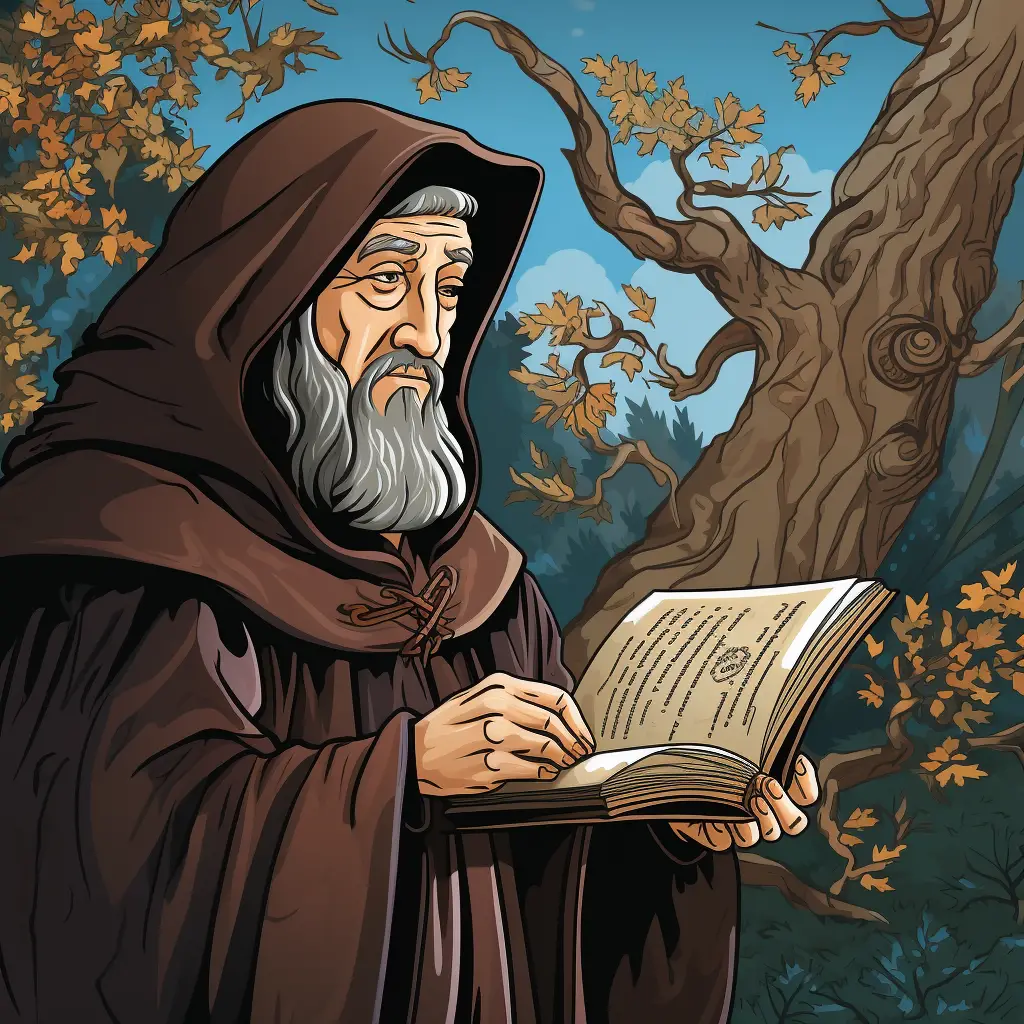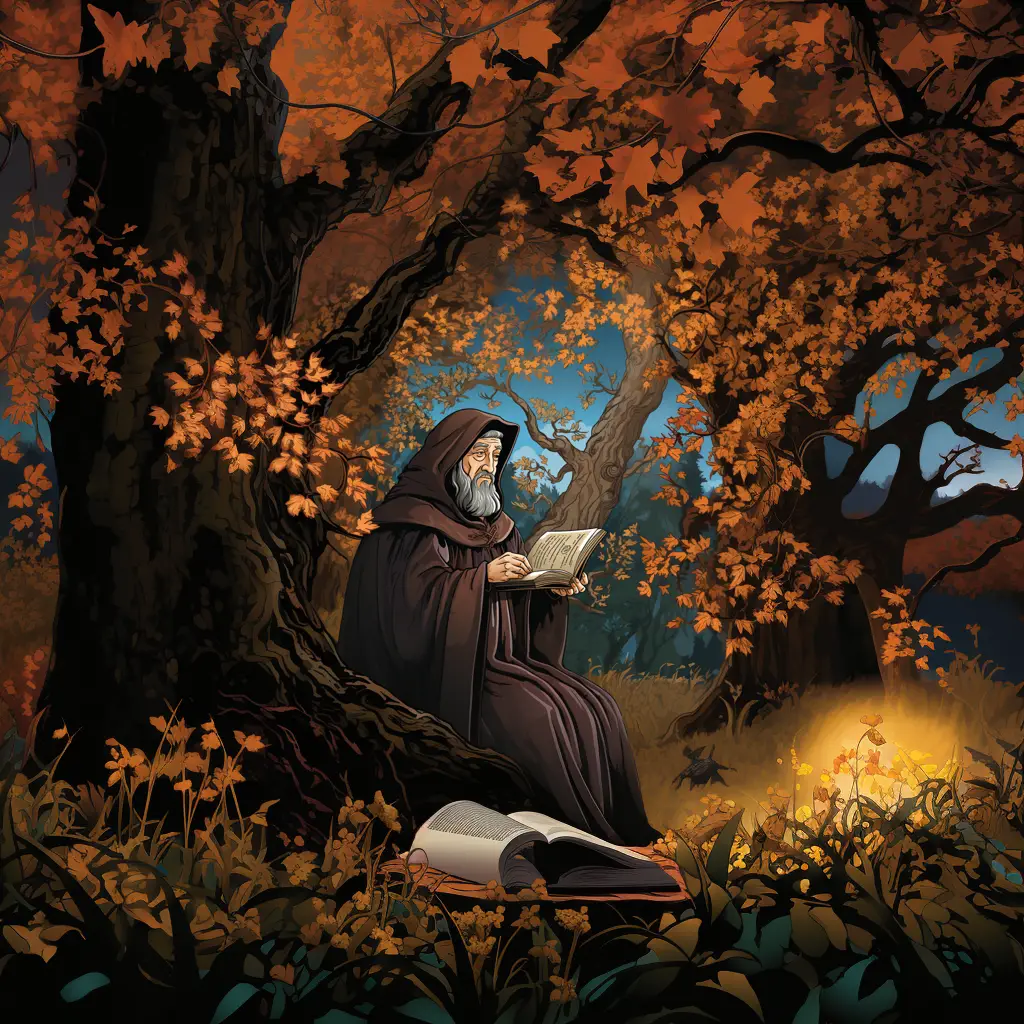Geoffrey Chauser
Geoffrey Chaucer was an English poet from the middle ages. He is widely celebrated as the Father of English Literature and the greatest English poet of the middle ages. Before Geoffery, the primary literary languages of England were French and Latin. He was the first one to use Middle English Vernacular, a version of the English language spoken post-Norman Conquest.
He earned acclaim as a poet, author, and philosopher but was also a full-time bureaucrat, courtier, and diplomat. Geoffrey’s best-known work is ‘The Canterbury Tales’, a collection of 24 stories. He was the first person to be buried in the poet’s corner in Westminster Abbey, a great honor and acknowledgment of his literary accomplishments.

Geoffrey Chaucer Facts for Kids
- Geoffrey Chaucer was born around 1343 in England.
- He’s known as the “Father of English Literature”.
- He wrote in Middle English, not Latin.
- His most famous work is “The Canterbury Tales”.
- He worked as a public servant and diplomat.
- Chaucer introduced new poetic forms to English.
- He used his works to critique social issues.
- He was the first writer buried in Poets’ Corner.
- He wrote in verse (poetry) and prose (regular writing).
- His works give a glimpse of medieval life.
The Canterbury Tales
Known as the father of English literature, Geoffrey Chaucer was born in London, England, around 1343, during the Middle Ages. His most renowned work, ‘The Canterbury Tales,’ is a collection of narratives shared by a diverse group of pilgrims journeying to Canterbury Cathedral.
This book holds particular significance as it was among the first major works written in English rather than the then-prevalent Latin or French. In it, Chaucer paints a vivid picture of life in the Middle Ages through the stories of characters from various social classes, including knights, nuns, and common workers.
Middle English Literature
Geoffrey Chaucer, the ‘Father of English literature’, was a seminal figure in Middle English Literature, born around 1343 in London, England, during the Middle Ages.
He is renowned for his writings in Middle English, a linguistic form prevalent from the late 11th century to the late 15th century. ‘The Canterbury Tales’, his most celebrated work, is a compilation of humorous, romantic, and occasionally scandalous stories narrated by diverse characters journeying to Canterbury, thereby engaging a broad readership.
Chaucer’s distinct contribution to literature was his decision to write in English instead of the then-dominant French or Latin, a choice that elevated the English language’s status and laid the foundation for its literary dominance in subsequent centuries.
Courtly Love
Geoffrey Chaucer, a prominent Middle Ages English writer, is commonly linked with Courtly Love – a prevalent romantic theme in medieval literature. This concept is notably featured in several stories in ‘The Canterbury Tales,’ his most renowned work.
Courtly Love characteristically involves a knight or nobleman expressing his profound, typically unreciprocated, affection for a high-status lady through poetry, songs, and noble deeds. The characters in Chaucer’s works frequently become embroiled in intricate love triangles and intense romantic quests, embodying the virtues and difficulties associated with Courtly Love.
Medieval Poetry
Geoffrey Chaucer, a famed figure in the sphere of Medieval Poetry, is often recognized as the ‘Father of English literature’ due to his significant contributions in the 14th century. He is most notable for his masterpiece, ‘The Canterbury Tales,’ a compendium of stories narrated by a band of pilgrims voyaging to Canterbury. His works, penned in a distinct form of English known as Middle English, offer a unique window into the lives of people in the Middle Ages. Notably, Chaucer has the distinctive honor of being the inaugural writer interred in the Poets’ Corner of Westminster Abbey, an iconic London church, reflecting the immense value of his contributions to Medieval Poetry and the development of the English language.
Pilgrimage in Medieval Culture
Geoffrey Chaucer achieved his greatest fame through ‘The Canterbury Tales,’ a book that presents an intriguing insight into the tradition of pilgrimage during the medieval era. Pilgrimages were religious journeys to holy sites, a common practice of the time.
In his book, Chaucer introduces a group of pilgrims journeying together to the Canterbury Shrine of Saint Thomas Becket. As they travel, each character shares a tale to amuse their companions, weaving together a diverse collection of narratives that illuminate various facets of medieval society.
Chaucer’s work provides a valuable resource, particularly for children, to comprehend that pilgrimages were not merely spiritual endeavors, but also significant social occasions enabling interactions and storytelling among people from diverse backgrounds.
The Wife of Bath
Geoffrey Chaucer is celebrated for his acclaimed series, ‘The Canterbury Tales,’ which introduces a host of diverse characters. Notably, ‘The Wife of Bath’, a bold woman married five times, is unafraid to express her perspectives on love, matrimony, and societal roles of women. This character breaks away from the traditional depiction of submissive and obedient women in literature of that period. Chaucer leverages her to challenge societal norms and inspire dialogue on gender roles and expectations, a relatively progressive move given his historical context. This character serves as an intriguing introduction for children to notions of gender equality and female empowerment.
Medieval English Society
Geoffrey Chaucer, an eminent English poet of the Middle Ages, offers an invaluable glimpse into medieval English society through his writings, prominently ‘The Canterbury Tales.’ This work, renowned for its portrayal of a diverse spectrum of characters from various social strata—such as a knight, a miller, a prioress, and a cook—unveils the norms, values, and structures of the time.
His vivid and humorous characterizations provide an understanding of the occupations, behaviors, and etiquettes prevalent during that era. Therefore, Chaucer’s writings serve as an engaging and enlightening resource for children to explore history and literature.
The Knight’s Tale

Geoffrey Chaucer, often hailed as the progenitor of English literature, penned a celebrated anthology known as ‘The Canterbury Tales,’ which includes a well-known narrative, ‘The Knight’s Tale.’ This tale, set in ancient Greece, showcases Chaucer’s fascination with and comprehension of diverse cultures and epochs. It narrates the poignant story of two knights, Arcite and Palamon, who, despite their shared captivity, find themselves embroiled in a triangle of love, envy, and desolation over Emily, a woman they both love.
‘The Knight’s Tale,’ written in the now antiquated Middle English, exemplifies Chaucer’s capacity for crafting intricate characters imbued with profound emotions. In continuation of its literary significance, many educational institutions incorporate this tale into their curriculum to provide students with an understanding of the evolution of the English language and literature over centuries.
Troilus and Criseyde
Geoffrey Chaucer, an eminent English author of the 14th century, penned a notable love narrative, ‘Troilus and Criseyde’, that revolves around the romance of a knight, Troilus, and a woman, Criseyde, during the Trojan War.
Chaucer, renowned for his usage of Middle English, distinct from contemporary English, employed expressive characters and poetic language to render his tales captivating. His pivotal work, ‘Troilus and Criseyde’, not only fortified his standing as a significant literary figure but also delved into universal themes like love, fate, and the implications of choices, presented in a manner comprehensible and enjoyable to even younger audiences.
Chaucer’s Influence on the English Language
Often hailed as the ‘Father of English Literature,’ Geoffrey Chaucer played a pivotal role in the evolution of the English language. Prior to Chaucer’s influence, the literary world and official documentation in England were primarily penned in French or Latin.
However, Chaucer boldly chose to compose his renowned work, ‘The Canterbury Tales,’ in English – a move that significantly contributed to the legitimization of English as a language apt for literature and scholarship. Not only did he introduce numerous new words to the language, but he also employed various regional dialects in his characters’ dialogues, effectively highlighting the diversity within the English language.
These groundbreaking contributions from Chaucer have undeniably helped mold the English language into its current form.

Early Life of Chaucer
Geoffrey was born in London in 1343. His father, John Chaucer was a winemaker and worked in London. As a teenager, Geoffrey started an apprenticeship when he joined the household of Elizabeth de Burgh, Countess of Ulster. Elizabeth was married to Lionel, the Duke of Clarence, son of King Edward III. His position in the household of Lionel provided him an opportunity to move in court circles.
He also worked for King Edward as his clerk for a few years. In 1359, he accompanied the Duke of Clarence as a part of the English Army on the invasion of France during the early part of the Hundred Years War. In 1360, he was taken as a prisoner during the siege of Reims. Lionel, the Duke of Clarence had to pay a ransom amount of £16 for his release. Chaucer subsequently performed different duties in the Royal court. During these days he wrote his first book ‘The Book of Duchess’ in honor of Blanche Lancaster, the late wife of Edward III’s son John the Gaunt.
In 1366, he married Philippa Roet, daughter of Sir Payne Roet and a lady in waiting for Philippa of Hainault, wife of King Edward III. This marriage helped him in furthering his career in the royal court.
He held several diplomatic positions in royal service. In 1373, Chaucer visited Genoa and Florence and was introduced to Italian medieval poetry. He was greatly influenced by it and it was reflected in his own work in later years. Chaucer was a close friend of John the Gaunt, Duke of Lancaster. His wife Philippa was the sister of John’s third wife, Katherine.
Work
Geoffrey Chaucer is credited with instituting the use of Middle English vernacular in his works. Prior to this, Latin and French were primarily used as literary languages in England. The best among his many works are The Book of the Duchess (he wrote it to commemorate the death of Blanche Lancaster, wife of Duke of Lancaster), Parliament of Fouls, The House of Fame, The Legend of Good Women and Troilus and Criseyde. However; his best-known work is ‘The Canterbury Tales’, a collection of twenty-four stories.
His non-fiction essay ‘A Treatise on Astrolabe’ is also a well-known work in which he elaborates on the use of the Astrolabe, an instrument used by astronomers to locate the position of the sun, moon, and planets.
Later Life
In the later years of his life, Geoffrey acted as Clerk of Works during the reign of Richard II. He found this job to be stressful and not very rewarding. By then his pension had been stopped. In 1391, he resigned from his job and took work as a sub-forester in King’s Park in Somersetshire. In 1399, Richard II’s successor, Henry IV reinstated Geoffrey’s pension which helped him live his remaining days with some dignity.
After a bout of brief illness, this celebrated poet and author met his maker on October 25, 1400, in London. He was buried in Westminster Abbey at a place that was later named Poet’s corner. Famous British authors like Robert Browning and Charles Dickens are also buried at the same location.



